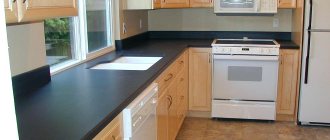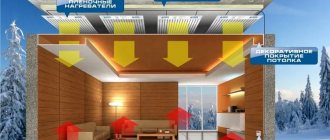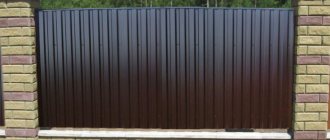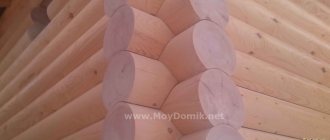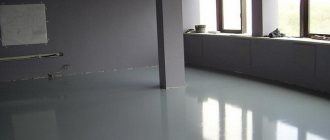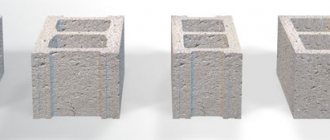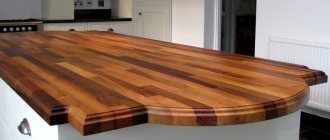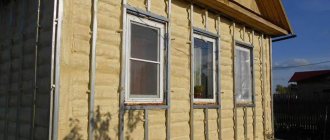Hi all! I think you will agree that not all people have a huge, inexhaustible budget that allows them to use the most expensive and also the most exclusive materials for home renovation and improvement. Therefore, you often have to look for a practical, high-quality, but inexpensive solution. If we talk about the kitchen, as well as work surfaces, then a plastic kitchen countertop can be such a solution.
Today we’ll talk about the pros and cons of products, and also discuss the varieties that manufacturers offer.
Tables can also be made from such materials. But they are mainly used as countertops.
Various sizes are offered. Here the client himself chooses what he needs. For some, a product with a depth of 700 mm is suitable, others will want to place a panel under the apron or replace the window sill with a tabletop. Not about that now.
Varieties and distinctive features
It is a mistake to think that a plastic kitchen countertop is a solid plastic-based product, like window sills. No. This is the name given to countertops that have a special protective and decorative coating.
In other words, a tabletop is called plastic, the base of which is made of chipboard or MDF, but the top layer is made of CPL or HPL plastic.
The type of plastic coating divides the canvas into 2 main types. They may also differ in product thickness, size, and appearance. But it is most correct to divide according to the type of plastic coating.
Both options can be made to resemble wood or marble, as well as imitate various natural materials and more. The choice is yours.
What are the differences between CPL and HPL
If you are interested in a plastic countertop for the kitchen, you definitely need to clarify what kind of coating is used for it.
HPL stands for High Pressure Laminate. It is a paper-laminated laminate. The raw material is kraft paper, which is impregnated with special phenolic resins. The multi-layered and monolithic nature of the plastic ensures high strength, as well as resistance to mechanical, chemical and temperature factors. The coating is more moisture-resistant, wear-resistant and fire-resistant. To improve the properties of products, an overlay is applied on top.
CPL plastic stands for Continuosely Pressed Laminate. The pre-production stage is the same as in the previous case. That is, the raw materials are kraft paper and impregnation from thermoactive phenolic resins. Then comes the overlay coating. But the difference lies in the manufacturing technology, as well as in the thickness of the sheets.
HPL is created using multi-deck presses with periodic pressure treatment of 50-90 bar. CPL is produced using a two-belt continuous pressing machine. The pressure varies from 30 to 70 bar.
There is also a difference in temperature effects. If for HPL it is about 120 degrees Celsius, then for CPL the temperature is from 150 to 170 degrees.
The nuances of production determine the thickness of the sheets. For HPL it is 0.5-4.0 mm, and for CPL it is from 0.15 to 1.5 mm.
If we talk about other characteristics, the materials here are largely identical.
Manufacturing processes as well as thickness affect the cost. HPL technology is more complex. But it has gained great popularity due to its best technical and operational characteristics.
Taking into account the conclusions made, it is the plastic countertop for the kitchen using HPL technology that will be more preferable. We will talk about it further.
Help when choosing granite countertops for the kitchen
Before placing an order for the manufacture of a product from this rock, it is useful to ask the supplier whether the product has a quality certificate. Some types of natural stone have increased radioactivity. In order for the use of granite to be safe for health, the level of specific activity of natural radionuclides (Aeff) should not exceed 370 Bq/kg - this is the first class of material. During the dialogue with the supplier’s representative, it is advisable to clarify what cleaning and masking agents can be used for this category of granite.
Overall dimensions of tabletops
It turns out that plastic is a kind of lining or coating for a base made of MDF and chipboard. This is how plastic countertops are made.
Manufacturers mostly use standard thickness sizes. These are 28 and 38 mm. Yes, they will certainly be thinner than concrete countertops, as well as ceramic tile kitchen countertops. But usually such parameters are more than enough.
A difference of 10 mm significantly affects the cost. A product with a thickness of 28 mm will cost 1.5 times less than a 38 mm panel.
If you want to get the most reliable option, then you need a thickness of 6 mm and a base made of lightweight chipboard or MDF. True, such options are rarely found on sale. Mostly they are made to order.
The width of the canvas is standard. Most of them are 60 cm. Less commonly, you can find products with a width of 30, 100 and 120 cm. The length varies from 244 to 420 cm.
Customer Reviews
A countertop made of artificial stone is still not a cheap purchase. Therefore, it is worth carefully studying the reviews of those who can already evaluate the quality of products from a particular manufacturer. For your convenience, we have collected several useful opinions from popular Internet forums.
What are the advantages and disadvantages
You have already decided that a plastic kitchen countertop is right for you. Just keep in mind that a slab that is too thin is not the best option. Consumer reviews also speak about this.
What color it will be is up to you. Even just white, or like stone or wood.
Plastic-coated countertops are a cheap alternative to luxury linens. At the same time, they look no worse. An excellent solution for a budget kitchen.
The main advantages include the following:
- high moisture resistance, which is very important for the kitchen;
- decent resistance to mechanical damage and abrasion over time;
- resistance to food acids and water vapor;
- heat resistance, which in the case of HPL plastic reaches 200 degrees Celsius;
- quite long service life.
But starting only from merits is not entirely correct.
You need to understand in advance what pitfalls you may encounter when choosing this product option.
The disadvantages here are the following:
- The unreliability of imitation
. Visually, manufacturers are trying to make the panel look like wood. But when examining the kitchen, it immediately becomes clear that this is an imitation. If you are accustomed to luxury and want a perfect imitation, then plastic countertops are definitely not your option; - Unsuitable for restoration
. Many swollen countertops can be restored with your own hands. The same stone products are ground and rubbed. If you damage the plastic, it's easier to replace it completely. The only solution is to buy a new countertop; - Penetration of moisture into joints
. Largely because of this, such products are not the best solution for the street. If moisture gets there, the product will soon swell. As it swells, the plastic itself becomes deformed. And here again there is no way to do without replacing the entire countertop.
Yes, these are rather conditional disadvantages. You can get rid of them if you initially choose a good product, and also adhere to all the rules for installation and further operation.
Kinds
Thanks to modern technologies, granite sheets can be processed in different ways, and the final result will have the following different textures:
- Polishing products allows you to create a mirror surface that reveals a unique pattern on the slab. It’s easy to wash off dirt from such a countertop, but the gloss requires constant cleaning, as it looks untidy at the slightest carelessness.
- Polished granite has a matte finish. The surface does not have a mirror shine, and therefore the texture of the stone is less clearly expressed.
- The “leather-like” treatment has a pleasant-to-touch roughness that does not in any way affect the quality of the material. Minor defects in natural stone become invisible, and the pattern and structure of the mineral are fully revealed.
Is it true that granite contains bacteria?
A well-made, well-treated countertop is impervious to bacteria because it is inherently non-porous. All you have to do to disinfect it is wipe it with soap and water or a special granite cleaner. If you're particularly concerned about contamination, such as after slicing meat on a granite counter, you can clean it with a mixture of half water and half isopropyl alcohol. Leave the mixture on for about three minutes, then wipe it off with a soft, damp cloth soaked in water.
Is it true that granite emits radiation?
The radiation comes from naturally occurring elements in rocks, including uranium, radium and thorium. There may be veins of these elements running through any stone, including certain slabs of granite. If present, these elements can release radon, a radioactive gas, into the air.
However, even if a rare slab of granite does emit radiation, the experts' position is that such radiation in building materials such as granite countertops poses no risk compared to that emitted from the soil under homes. The radon emitted by granite is diluted by ventilation systems, so its health effects are minimal, so radiation from granite will not exceed annual radiation doses above normal permissible levels.
Is it true that granite quickly loses its shine and becomes dull?
It is true that granite products will become dull and worn if not cared for properly. Additionally, if you use harsh cleaners such as bleach and scouring powder, the surface of the granite will dull, and a rough or rough sponge or cloth may also leave scuff marks on the surface of the stone and remove its shine. However, if you clean your granite thoroughly with plain water, a mild granite cleaner or dish soap, and soft sponges, it will remain shiny and maintain its pristine appearance for many years.
Price
Due to the strength of the rock, mining, cutting and processing procedures are quite expensive. The final price per linear meter of countertops is influenced by the following factors:
- The number of solid slabs that will be involved in the manufacture of the product. Remaining amounts are most often included in the price.
- The price of the rock, which depends on the place of extraction, the depth of the quarry and the rarity of the selected species.
- Method of processing end edges. The more complex the profile shape, the more expensive the order will be.
- Delivery of a heavy product including lifting to the floor.
A three-meter countertop with the simplest end and a thickness of 2 cm, which has standard holes for a sink, stove and mixer, can cost about 33 thousand rubles.
